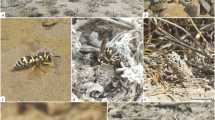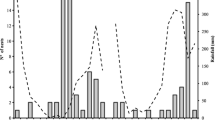Summary
Nest architecture ofHalictus ligatus was studied at Victoria, southern Ontario; over 130 nests were excavated in 1984. The most important findings are as follows. Nest failure was lower in vegetated areas than in bare ground. Nests with entrances hidden under leaves may suffer less mortality from parasites than those out in the open. Loops around cells are dug in response to moist soil conditions and appear to be an intermediate step towards cavity formation. Brood mortality due to mould seemed to result from cell waterlogging which the excavation of loops may help to prevent. Cells near the surface may suffer from waterlogging after heavy rains. Nests situated in denser vegetation suffered less mortality from mould. Gyne-producing cells are larger than male or worker-producing ones. Mandibular wear is an accurate measure of the amount of excavation performed by an individual female.
Resume
On étudie, dans le sud de l'Ontario, l'architecture des nids deHalictus ligatus; on déterre pour cela, en 1984, plus de 130 nids. Les principales découvertes sont les suivantes. La survie des nids est plus grande sur des surfaces recouvertes de végétation que sur des sols dénudés. Les nids dont les entrées sont dissimulées sous des feuilles souffrent moins de mortalité par prédateurs et parasites que ceux dont les entrées sont apparentes. Des boucles entourant les cellules sont construites pour prévenir une trop grande humidité du sol et semblent constituer une étape intermédiaire vers la formation d'une cavité. La mortalité du couvain due à l'humidité semble résulter d'un excès d'eau que l'excavation de boucles pourrait contribuer à prévenir. Les cellules situées près de la surface peuvent souffrir d'un excès d'humidité après de fortes pluies. Les nids situés sous une végétation plus dense souffrent moins de mortalité par moisissure. Les cellules produisant des reines sont plus grandes que celles qui donnent des mâles et des ouvrières. L'usure mandibulaire est une mesure précise du creusement accompli par un individu femelle.
Similar content being viewed by others
References
Chandler L., 1955. — The ecological life history ofHalictus (H.) ligatus Say with notes on related species.Unpublished Ph. D. Thesis, Purdue University.
Eickwort G.C., 1985. — The nesting biology of the sweat beeHalictus farinosus in California with notes onH. ligatus (Hymenoptera: Halictidae).Pan-Pac. Ent., 61, 122–137.
Eickwort G.C., Sakagami S.F., 1979. — A classification of nest architecture of bees in the tribe Augochlorini (Hymenoptera: Halictidae; Halictinae), with description of a Brazilian nest ofRhinocorynura inflaticeps.Biotropica, 11, 28–37.
Kamm D.R., 1974. — Effects of temperature, day length, and number of adults on the sizes of cells and offspring in a primitively social bee (Hymenoptera: Halictidae).J. Kans. Ent. Soc., 47, 8–18.
Kirkton R.M., 1963. — An analysis of caste differentiation in the field population structure ofHalictus ligatus Say.Unpublished Ph. D. Thesis, Purdue University.
Kirkton R.M., 1968. — Biosystematic analysis of variation ofHalictus (Halictus) ligatus Say.Unpublished Ph. D. Thesis, Purdue University.
Knerer G., 1973. — Periodizität und Strategie der Schmarotzer einer sozialen Schmalbiene,Evylaeus malachurus (K.) (Hymenoptera: Halictidae).Zool. Anz., 190, 41–63.
Knerer G., 1980. — Biologie und Sozialverhalten von Bienenarten der GattungHalictus Latreille (Hymenoptera, Halictidae).Zool. Jahrb. Abt. Syst. Oekol. Geogr. Tiere, 107, 511–536.
Kumar S., 1975. — Relations among bee size, cell size, and caste, inLasioglossum zephyrum (Hymenoptera, Halictidae).J. Kans. Ent. Soc., 48, 374–380.
Litte M., 1977. — Aspects of the social biology of the beeHalictus ligatus in New York state (Hymenoptera, Halictidae).Insect. Soc., 24, 9–36.
May D.G.K., 1970. — Brood care in Halictid bees.Science, 170, 651–652.
May D.G.K., 1972. — Water uptake during larval development of a sweat bee,Augochlora pura (Hymenoptera: Apoidea).J. Kans. Ent. Soc., 45, 439–449.
Michener C.D., Bennett F.D., 1977. — Geographical variation in nesting biology and social organisation ofHalictus ligatus.Univ. Kans. Sci. Bull., 51, 233–260.
Ordway E., 1966. — The bionomics ofAugochlorella striata andA. persimilis in eastern Kansas.J. Kans. Ent. Soc., 39, 270–313.
Packer L., 1985. — Two social halictine bees from Southern Mexico with a note on two bee hunting philanthines (Hymenoptera: Halictidae and Sphecidae).Pan-Pac. Ent., 61, 291–298.
Packer L., Knerer G., 1985. — Social evolution and its correlates in bees of the subgenusEvylaeus (Hymenoptera: Halictidae).Behav. Ecol. Sociobiol., 17, 143–149.
Packer L., Knerer G., 1986. — The biology of a subtropical population ofHalictus ligatus I. Social organisation and phenology.Behav. Ecol. Sociobiol., 18, 363–375.
Plateaux-Quénu C., 1973. — Construction et évolution annuelle d'un nid d'Evylaeus calceatus (Scopoli) (Hym., Halictinae) avec quelques considérations sur la division du travail dans les sociétés monogynes et digynes.Insect. Soc., 20, 297–320.
Plateaux-Quénu C., 1983. — Le volume d'un pain d'abeille influence-t-il le sexe de l'œuf pondu sur lui? Etude expérimentale portant sur la première couvée d'Evylaeus calceatus (Scop) (Hym., Halictinae).Ann. Sci. Nat. Zool. Paris, Serie 13, 5, 41–52.
Roberts R.B., 1973. — Bees of nothwestern America:Halictus.Oregon State Univ. Agr. Expt. Sta. Tech. Bull., 126, 1–23.
Sakagami S.F., Fukuda H., 1972. — Life of a Japanese eusocial halictine bee,Lasioglossum duplex out of brood rearing season (Hymenoptera, Halictidae).Insect. Soc., 19, 137–152.
Sakagami S.F., Michener C.D., 1962. —The nest architecture of the sweat bees, University of Kansas Press, Lawrence.
Author information
Authors and Affiliations
Rights and permissions
About this article
Cite this article
Packer, L., Knerer, G. An analysis of variation in the nest architecture ofHalictus ligatus in Ontario. Ins. Soc 33, 190–205 (1986). https://doi.org/10.1007/BF02224597
Received:
Accepted:
Issue Date:
DOI: https://doi.org/10.1007/BF02224597




